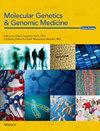与 RAD21 变异相关的科尼莉亚-德-朗格综合征 4 型的临床特征、遗传分析和文献综述
IF 1.5
4区 医学
Q4 GENETICS & HEREDITY
引用次数: 0
摘要
背景康尼利亚-德-朗格综合征(CdLS)是一种不常见的先天性发育障碍,以智力障碍和独特的面部特征为主要特征,少数病例可归因于RAD21变异。结果一名 13.3 岁的男性患者身高 136.5 厘米(-3.5 SDS),体重 28.4 千克(-3.1 SDS),具有典型的颅面特征。WES 发现 RAD21 基因中存在致病变异 c.1143G>A(p.Trp381*)。他被诊断为 CdLS 4 型(OMIM #614701)。我们回顾了 2012 年 5 月至 2024 年 3 月全球报道的与 RAD21 基因变异有关的 36 例 CdLS 患者。我们总结了患者的变异状态、临床特征和 rhGH 治疗反应。框架移位变异是最主要的变异类型,占病例的36%(13/36)。结论本研究报告了中国第三例由RAD21基因变异引起的CdLS 4型,丰富了基因突变谱。本文章由计算机程序翻译,如有差异,请以英文原文为准。
Clinical Characteristics, Genetic Analysis, and Literature Review of Cornelia de Lange Syndrome Type 4 Associated With a RAD21 Variant
BackgroundCornelia de Lange syndrome (CdLS) is an uncommon congenital developmental disorder distinguished by intellectual disorder and distinctive facial characteristics, with a minority of cases attributed to RAD21 variants.MethodsA patient was admitted to the endocrinology department at Peking Union Medical College Hospital, where 2 mL of peripheral venous blood was collected from the patient and his parents. DNA was extracted for whole‐exome sequencing (WES) analysis, and the genetic variation of the parents was confirmed through Sanger sequencing.ResultsA 13.3‐year‐old male patient with a height of 136.5 cm (−3.5 SDS) and a weight of 28.4 kg (−3.1 SDS) was found to have typical craniofacial features. WES revealed a pathogenic variant c.1143G>A (p.Trp381*) in the RAD21 gene. He was diagnosed with CdLS type 4 (OMIM #614701 ). We reviewed 36 patients with CdLS related to RAD21 gene variants reported worldwide from May 2012 to March 2024. Patient's variant status, clinical characteristics, and rhGH treatment response were summarized. Frameshift variants constituted the predominant variant type, representing 36% (13/36) of cases. Clinical features included verbal developmental delay and intellectual disorder observed in 94% of patients.ConclusionThis study reported the third case of CdLS type 4 in China caused by a RAD21 gene variant, enriching the genetic mutational spectrum.
求助全文
通过发布文献求助,成功后即可免费获取论文全文。
去求助
来源期刊

Molecular Genetics & Genomic Medicine
Biochemistry, Genetics and Molecular Biology-Genetics
CiteScore
4.20
自引率
0.00%
发文量
241
审稿时长
14 weeks
期刊介绍:
Molecular Genetics & Genomic Medicine is a peer-reviewed journal for rapid dissemination of quality research related to the dynamically developing areas of human, molecular and medical genetics. The journal publishes original research articles covering findings in phenotypic, molecular, biological, and genomic aspects of genomic variation, inherited disorders and birth defects. The broad publishing spectrum of Molecular Genetics & Genomic Medicine includes rare and common disorders from diagnosis to treatment. Examples of appropriate articles include reports of novel disease genes, functional studies of genetic variants, in-depth genotype-phenotype studies, genomic analysis of inherited disorders, molecular diagnostic methods, medical bioinformatics, ethical, legal, and social implications (ELSI), and approaches to clinical diagnosis. Molecular Genetics & Genomic Medicine provides a scientific home for next generation sequencing studies of rare and common disorders, which will make research in this fascinating area easily and rapidly accessible to the scientific community. This will serve as the basis for translating next generation sequencing studies into individualized diagnostics and therapeutics, for day-to-day medical care.
Molecular Genetics & Genomic Medicine publishes original research articles, reviews, and research methods papers, along with invited editorials and commentaries. Original research papers must report well-conducted research with conclusions supported by the data presented.
 求助内容:
求助内容: 应助结果提醒方式:
应助结果提醒方式:


